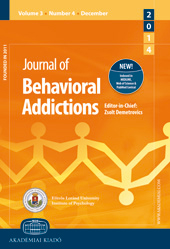Spanish validation of the Sexual Addiction Screening Test
Spanish validation of the Sexual Addiction Screening Test
Author(s): Jesús Castro-Calvo, Rafael Ballester-Arnal, Joël Billieux, Beatriz Gil-Juliá, María Dolores Gil-LlarioSubject(s): Gender Studies, Behaviorism
Published by: Akadémiai Kiadó
Keywords: Sexual Addiction Screening Test (SAST); Spanish validation; psychometric properties; compulsive sexual behavior; hypersexuality
Summary/Abstract: Background and aims. Sexual addiction is a pathological behavior characterized by a combination of excessive sexual desire and impaired ability to control it. Its incidence ranges between 1.2% and 32.2%, although this number may vary depending on the screening tool used. This wide variability is largely due to the use of non-validated instruments (e.g., structural validity relying on exploratory analyses, instruments translated without an additional validation process, or instruments validated in another format). To deal with these limitations, this study tested the psychometric properties of the Spanish paper-and-pencil and online versions of the Sexual Addiction Screening Test (SAST). Methods. A total of 2,528 participants (1,163 males) completed the Spanish version of the SAST, along with other instruments assessing sexual compulsivity (1,585 = paper-and-pencil, 943 = online). Results. The exploratory factor analysis yielded a four-factor structure explaining 57.39% of the variance for the SAST paper-and-pencil version. This factor structure was then verified for the online version through the use of confirmatory factor analysis [χ2(264) = 441.59; χ2/df = 1.66; RMSEA = 0.02; CFI = 0.94; IFI = 0.94]. This methodology was also used to support measurement invariance (configural, metric, and scalar invariance) according to gender. The reliability of the total score ranged from .82 to .85. Similarly, correlations with related scales were positive and significant (r between .22 and .71). Temporal stability 1 year after the first application was 0.65 (paper-and-pencil format) and 0.60 (online version). Conclusion. These results, together with the absence of questionnaires translated into Spanish to assess this construct, justify the use of the SAST in the evaluation of sexual addiction in Spanish-speaking countries.
Journal: Journal of Behavioral Addictions
- Issue Year: 7/2018
- Issue No: 3
- Page Range: 584-600
- Page Count: 17
- Language: English

